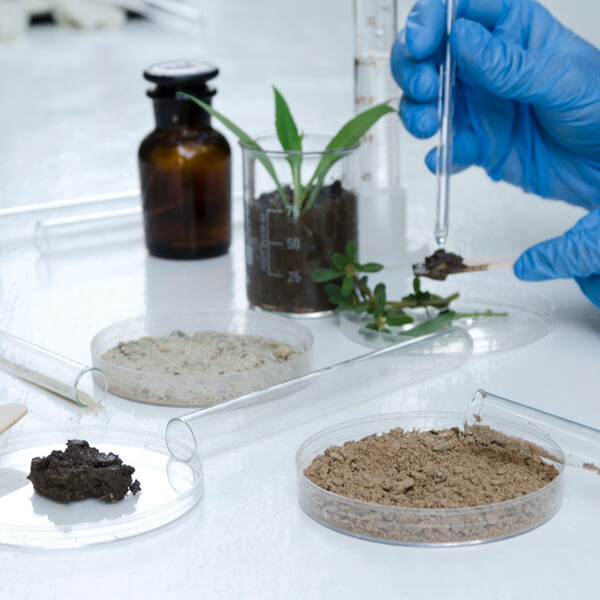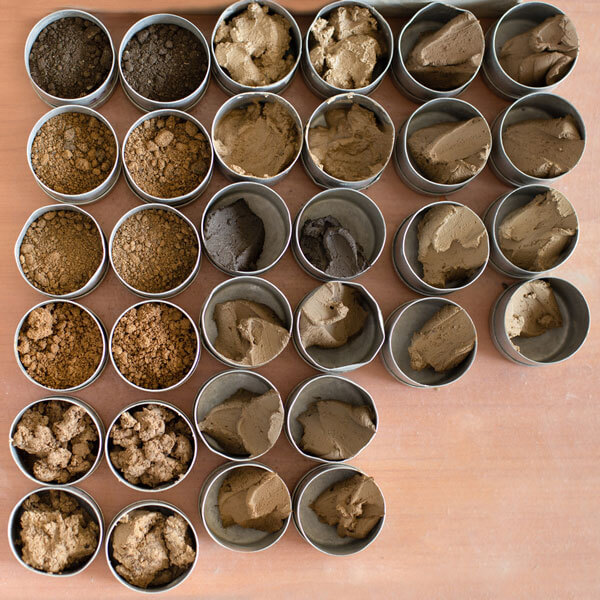Soil Testing

Sediment and Sludge Testing:
Sediment and sludge testing are crucial components of soil testing, evaluating the quality and characteristics of sediments and sludges present in soils. These materials can significantly influence soil health by altering its physical, chemical, and biological properties. Understanding the properties of sediments and sludges is essential for assessing their impact on soil health, water quality, and potential environmental risks. Testing includes total solids, pH, organic matter content, nutrient analysis, heavy metals analysis, organic pollutant screening, pathogen detection, and particle size analysis. These tests help determine the most suitable methods for waste management and minimize environmental hazards. By conducting comprehensive sediment and sludge testing, environmental scientists, regulators, and land managers can make informed decisions regarding waste management, soil remediation, and protection of soil and water resources. Proper testing ensures responsible handling of sediments and sludges, reducing environmental impacts and promoting sustainable land use practices.
Compost Testing:
Compost testing is a crucial aspect of soil testing, evaluating the quality and nutrient content of compost to determine its suitability for soil improvement and fertilization. Compost is a valuable organic material that can improve soil fertility, water retention, and plant health. Proper testing ensures that the compost is safe, effective, and compatible with specific soil and crop requirements. Tests include nutrient analysis, pH and electrical conductivity, carbon-to-nitrogen ratio (C:N), maturity and stability, pathogen testing, heavy metal content, and contaminants screening. By analyzing these factors, farmers and gardeners can make informed decisions about compost application, promoting sustainable agricultural practices, reducing reliance on chemical fertilizers, and promoting healthier soils and environmentally friendly crop production.

TCLP:
Soil testing is essential for assessing the environmental impact of hazardous waste materials, particularly soils. The Toxicity Characteristic Leaching Procedure (TCLP) test is a standardized laboratory test that evaluates the potential for leaching hazardous constituents from solid wastes into the environment. It involves sample preparation, solid-to-liquid ratio, leaching procedure, filtering, and chemical analysis. TCLP holds significant importance in environmental laboratories for regulatory compliance, risk assessment, environmental impact, site remediation, and data-driven decisions. It helps determine whether a waste material is classified as hazardous under regulations like the Resource Conservation and Recovery Act (RCRA) in the United States and helps design containment systems to prevent leaching and contamination. TCLP testing also guides remediation efforts by identifying hazardous constituents and their leaching potential, aiding in determining appropriate cleanup methods. Overall, TCLP testing is a critical component of soil testing in environmental laboratories, providing valuable insights into the leaching potential of hazardous constituents from solid waste materials.
SPLP:
Soil testing is crucial for evaluating the environmental impact of contaminants on soil and groundwater. The Synthetic Precipitation Leaching Procedure (SPLP) test is a vital tool for evaluating the mobility and leaching potential of contaminants from soil and solid waste materials. The SPLP test simulates the effects of rainfall on contaminated soil, helping to predict the migration of pollutants and their potential environmental impact. The test involves sample collection, preparation of a synthetic leachate solution, leaching procedure, equilibrium period, and filtration and analysis. The SPLP test holds significant importance in environmental laboratories for several reasons. It provides a more accurate representation of contaminants’ mobility, aiding in predicting potential movement in real-world scenarios. It can be customized to replicate site-specific conditions, providing insights into contaminants’ behavior under different soil types and climatic conditions. The test also aids in risk assessment, regulatory compliance, remediation strategies, and environmental impact assessment. Overall, the SPLP test is a valuable tool in soil testing for environmental laboratories, providing critical insights into the mobility and potential migration of contaminants, aiding in risk assessment, regulatory compliance, remediation planning, and overall environmental impact assessment.
Test Names and Methods Involved in Soil Testing
- Acetaldehyde by HPLC
SW-846 8315A - Acetone by GC
SW-846 8015B - Acetone by GC/MS
SW-846 8260B - Acid Extractable
SW-846 8270C - Acidity
EPA 305.1 - Alcohols (n-Butanol, tert-Butanol, Ethanol, Methanol, and 2-Propanol)
SW-846 8015B - Ammonia Nitrogen
EPA 350.3 - Anion, Individual (Br, Cl, F, NO2, NO3, PO4, and SO4)
EPA 300 - Anions Scan (Br, Cl, F, NO2, NO3, PO4, and SO4)
EPA 300 - Appendix IX, Chlorinated Herbicides
SW-846 8151A - Appendix IX, Cyanide
SW-846 9012A - Appendix IX, Metals
SW-846 6010C/6020 - Appendix IX, Organochlorine Pesticides
SW-846 8081A/8082 - Appendix IX, Organophosphorous Pesticides
SW-846 8141A - Appendix IX, Semivolatiles
SW-846 8270C - Appendix IX, Sulfide
SW-846 9030BM/9034 - Appendix IX, Volatiles
SW-846 8260B - Ash
ASTM D482-95 - Base / Neutral Extractables
SW-846 8270C - BNA (Base / Neutral Extractables & Acid)
SW-846 8270C - Bromide
EPA 300 - BTEX
SW-846 8021B - BTEX + MTBE
SW-846 8021B - BTEX by GC/MS
SW-846 8260B - BTU (British Thermal Units)
ASTM D-240 - Chloride
SW-846 9212
EPA 300 - Chlorinated Volatiles
SW-846 8260B - Chromium, Hexavalent
SW-846 3060A/7196A - Chromium, Trivalent
SW-846 3060A/7196A - COD (Chemical Oxygen Demand)
EPA 410.4 - Conductance, Specific
EPA 120.1 - Corrosivity, pH
SW-846 Chapter 7 - Cresols
SW-846 8270C - Cyanide, Amenable
SW-846 9014 - Cyanide, Total
SW-846 9010B/9014 - Density / Specific Gravity
SM 2710F - DRO (Diesel Range Organics)
SW-846 8015B - EOX (Extractable Organic Halide)
SW-846 9023 - Ethanol
SW-846 8015B - Ethylene Glycol
SW-846 8015B - Fingerprint by GC Scan
SW-846 8015B - Flash Point (Ignitability)
SW-846 1010 - Fluoride
EPA 300 - Formaldehyde
SW-846 8315A - Glycols (Ethylene Glycol, Diethylene Glycol, Propylene Glycol, Triethylene Glycol)
SW-846 8015B - GRO (Gasoline Range Organics)
SW-846 8015B - Halogenated Volatiles
SW-846 8260B - Herbicides, Chlorinated
SW-8151A - Herbicides, Priority Pollutants
SW-8151A - Hexavalent Chromium
SW-846 3060A/7196A - Ignitability (Flash Point)
SW-846 1010 - Lead
SW-846 6010C/6020 - Lead in Paint
SW-846 6010C/6020 - Mercury
SW-846 7470A/7471A - Metals RCRA (Ag, As, Ba, Cd, Cr, Hg, Pb, Se)
SW-6010C/6020/7470A - Metals
SW-846 6010C/6020 - Metals, Individual (Al, As, Ag, B, Ba, Be, Ca, Cd, Co, Cr, Cu, Fe, Mg, Mn, Mo, Na, Ni, K, Pb, Se, Si, Sb, Ti, Tl, V, Zn)
SW-846 6010C/6020 - Metals, Individual, Special (Au, Bi, Li, Pd, Pt, Sr, S, Sn, W, Zr)
SW-846 6010C/6020 - Metals, Land Application (As, Cd, Cr, Cu, Pb, Mo, Ni, P, K, Se, Zn, Hg (Phosphorus can be analyzed in metals group))
SW-846 6010C/7471A - Metals, Priority Pollutant
SW-846 6010C/6020 - Metals, Scan (Semiquantitative)
SW-846 6010C/6020 - Methanol
SW-846 8015B - Moisture
EPA 160.3 modified - MTBE (Methyl tert-butyl ether)
SW-846 8021B - Napthalene
SW-846 8260B - n-Butanol
SW-846 8015B - Nitrate Nitrogen by IC
EPA 300 - Nitrogen, Ammonia
EPA 350.3 - Nitrogen, Organic
EPA 351.4/350.3 - Nitrogen, TKN
EPA 351.4 - Nitrogen, Total
EPA 351.4/300 - PAH by GC/MS
SW-846 8270C - PAH by HPLC
SW-846 8310 - PCB in Soil
SW-846 3580A/8082 - Percent Moisture
EPA 160.3 modified - Percent Solids
SM 2540B - Pesticides, Organochlorine
SW-846 8081A - Pesticides, Organophosphorus
SW-846 8141A - Pesticides, Priority Pollutant
SW-846 8081A
SW-846 9045 - pH
SW-846 9045C - Phenolics (Total Phenols)
SW-846 9066 - Phenols by GC/MS
SW-846 8270C - Priority Pollutants Package (Cyanide, Metals, PCBs, Pesticides, Phenols, Semivolatiles, and Volatiles)
EPA / SW-846 - RCI (Reactive Cyanide & Sulfide, Corrosivity (pH), and Ignitability)
SW-846 - RCRA Metals (Ag, As, Ba, Cd, Cr, Hg, Pb, Se)
SW-6010C/6020/7470A - Reactive Cyanide
SW-846 Chapter 7.3.4 - Reactive Sulfide
SW-846 Chapter 7.3.4 - Resistivity
EPA 120.1 - Semivolatiles by GC/MS
SW-846 8270C - Semivolatiles Scan by GC/MS
SW-846 8270C - Semivolatiles, Priority Pollutants
SW-846 8270C - Silica (Dissolved)
EPA 1683 - Specific Conductance
EPA 120.1 modified - Specific Gravity – Density
SM 2710F - SPLP Extraction (Synthetic Precipitation Leachate Procedure)
SW-846 1312 - Sulfate
EPA 300 - Sulfite
SW-846 9030B/9034
EPA 376.1/376.2 - TCLP Benzene
SW-846 /1311/8021B - TCLP BTEX
SW-846 /1311/8021B - TCLP Full Package (TCLP VOC, TCLP SV, TCLP Pesticides, TCLP Herbicides, TCLP Metals)
SW-846 - TCLP Extraction: Non-volatile Extraction
SW-846 1311 - TCLP Extraction: ZHE
SW-846 1311 - TCLP Grit Trap (TCLP VOC, TCLP Metals, and RCI)
SW-846 - TCLP Herbicides
SW-846 1311/8151A - TCLP Mercury
SW-846 1311/7470A - TCLP Metals (As, Ba, Cd, Cr, Pb, Se, Ag, Hg)
SW-846 1311/6010C/7470 - TCLP Metals, Individual (Ag, As, Ba, Cd, Cr, Pb, Se)
SW-846 1311/6010C/6020 - TCLP Metals, Texas (Ag, As, Ba, Be, Cd, Cr, Ni, Pb, Sb, Se, Hg)
SW-846 1311/6010C/6020/ - TCLP Package, w/o Pesticides and Herbicides (TCLP Metals, TCLP VOC, TCLP SVOC)
SW-846 - TCLP Pesticides
SW-846 1311/8081A - TCLP Semivolatiles
SW-846 1311/8270C - TCLP Volatiles
SW-846 1311/8260B - TKN (Total Kjeldahl Nitrogen)
EPA 351.4 - TOC (Total Organic Carbon)
EPA 415.2 - TOX / TOH (Total Organic Halide)
SW-846 9023 - TPH by GC (DRO & GRO)
SW-846 8015B - TPH, Texas 1005
Texas 1005 - TPH, Texas 1006
Texas 1006 - TPH-DRO
SW-846 8015B - TPH-GRO
SW-846 8015B - Trivalent Chromium (Requires Total and Hexavalent Chromium)
SW-846 3060A/7196A - Volatiles (VOC)
SW-846 8260B - Volatiles (VOC) Scan by GC/MS
SW-846 8260B - Volatiles (VOC), Chlorinated
SW-846 8260B - Volatiles (VOC), Priority Pollutants
SW-846 8260B
